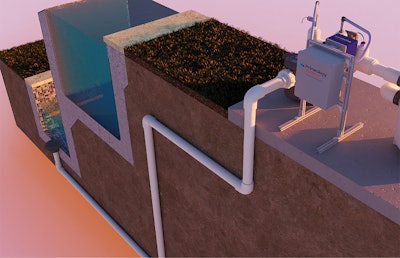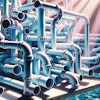
Most of the time, the pool circulation pump takes its place in line, ahead of the filter and close to the level of the water, where it primes without difficulty.
But sometimes, there are reasons the pump needs to go well above the surface of the pool, and then, as a designer, you've got an issue because pumps struggle to prime as they move higher above the waterline. So you contort and strain your design to meet your imperatives while still keeping that pump down low where it will be sure to prime. And maybe you figure out a solution, but it's a bit of a shotgun marriage in the end, whereas the design would be much more elegant and efficient if you could just put the pump up high, where it needs to be located for the site or in some cases, the code requirements.
And now you can. Mark Dorsey, P.E. of Medallion Pool Co., Asheville, N.C., an accomplished builder in his own right, got frustrated with the problem and invented something that obviates it completely. Let him tell you about it:
"This is just a design tool we've never had. It's a tool you may not have ever thought about having, but it allows you to save money and put the equipment where it needs to go, regardless of elevation."
"WHY HAVEN'T WE SOLVED THIS PROBLEM?"
Necessity is the mother of invention, and the product was born of Dorsey's own need to design with elevated pumps.
"I was working on a large commercial project in the mountains of Colorado, and I needed to drop a pool just a couple of feet below the equipment room (which could not be moved) in elevation to accommodate a slide in the side of a hill, which was crucial to the project. Every builder knows that large commercial pumps just don't prime well, even at 2 or 3 feet above the water surface," he says.
"And as I wrestled with the configuration, I said out loud to one of the guys in the office, 'Why in the heck have we not solved this problem?'
"It has always been an issue. If you search for priming videos on YouTube, if you talk to anybody who knows, even pump manufacturers, they advertise their pumps as self priming, but they're not really."
 Pump layout for vanishing-edge pool and surge tank.
Pump layout for vanishing-edge pool and surge tank.
THE PROBLEM
"The problem is," Dorsey explains, "if we locate a pump above the water surface, it doesn't prime because centrifugal pumps just aren't designed to move air. If the pump is off for more than a few hours, air is drawn into the piping through things like ozonators, filters, and pump lids, to name a few and consequentially, the water drains down, and then, when you start up again, the pump can't move water due to the air in the pump. The pump just sits there and spins and overheats, and eventually you burn up the motor or even melt the plumbing."
The ANSI standard for self-priming pumps says that a certified pump can lift water 5 feet in 10 minutes. That 5 feet of elevation does not account for long slow rises in the piping or multiple pipes, and pumps running dry will get very hot long before 10 minutes has elapsed.
"On residential pools in some coastal areas, builders are required to put the equipment above flood stage elevation. They're putting a check valve in the suction piping as low as they can put it, which stops the water from draining down, but adds substantial head loss, and when it catches debris, you have a pump that is likely going to burn up unless someone detects the problem quickly. As for me, and especially for my clients, I don't want to have a situation that I know is eventually going to fail with costly repairs and downtime for my client."
SUCK IT UP, BUTTERCUP
Dorsey hopes Primeology will not only solve a number of problems builders face but will change the way they think about design and equipment location. "For me," he says, "It has changed the way I approach the projects I design and build. I am saving money and labor costs by using it on about 15% of my own projects."
There are a number of situations where locating pumps with total freedom is advantageous, but the most common is probably vanishing-edge pools.
"When you've got a vanishing-edge pump, and you've got a surge tank, and whether you're on steep ground or flat ground, there's financial benefits, client benefits and functional benefits to having that equipment up and together. Yes, you could put the pump in a vault, but that's really expensive and adds complexity that is just no longer necessary."
Dorsey hopes that if his invention can take equipment elevation out of the equation, there is potential to save thousands of dollars and make equipment installation simpler and easier.
"I'm a pool builder who wants to elevate the industry. I want to bring our industry to the forefront of technology and expertise and innovation. And I think this product advances that evolution, because in many cases, it gives you the freedom to design without that encumbrance, that limitation in the location of your equipment.
"It excites me as a designer because I never have to say to a client again: "No, we can't put it there, your equipment has to be located at or below the pool."








































